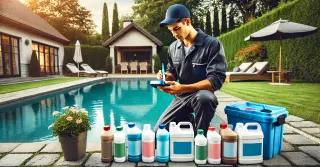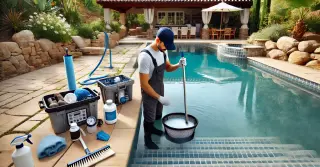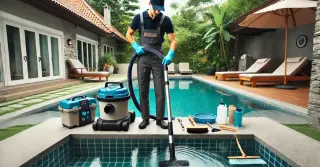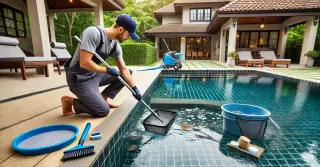Pool Chemical Balance Flanders NJ

Maintaining the proper chemical balance is essential for a safe and enjoyable swimming experience. Correct chemical levels stop algae and bacteria growth, ensure clear water and protect pool surfaces and equipment.
- Balancing pH Levels: The pH level of your pool water is a measure of its acidity or alkalinity. A balanced pH level should be between 7.2 and 7.6. Low pH levels result in acidic water, causing skin irritation and equipment corrosion. If the pH is too high, the water becomes alkaline, leading to cloudy water and scaling on the pool surfaces. Frequent pH testing and adjustments is essential to maintain a comfortable and safe swimming environment.
- Monitoring Chlorine Levels: Chlorine is essential for pool hygiene, as it kills bacteria, algae, and other harmful microorganisms. Optimal chlorine levels range from 1 to 3 ppm. Too little chlorine can lead to unsanitary conditions, allowing bacteria and algae to thrive. High chlorine levels result in skin and eye irritation and create a strong chlorine smell. Consistently monitoring and adjusting chlorine levels ensures sanitation and comfort.
Optimal Alkalinity LevelsTotal alkalinity is a crucial element of pool chemistry. Alkalinity acts as a buffer for pH levels, helping to prevent drastic changes in pH. The ideal range for total alkalinity is between 80-120 ppm.
- Preventing pH Swings: Correct alkalinity levels ensure stable pH, preventing rapid pH shifts that cause skin irritation and surface damage. Low alkalinity results in unstable pH levels, making balance maintenance challenging. Excessive alkalinity results in cloudy water and scaling. Frequent alkalinity testing and adjustments is essential for maintaining a stable and balanced pool.
- Balancing Calcium Levels: Calcium hardness indicates the calcium level in pool water. Proper calcium hardness levels range from 200 to 400 ppm. Insufficient calcium causes corrosive water, damaging surfaces and equipment. Excessive calcium causes scaling and water cloudiness. Frequent calcium hardness testing and adjustments is crucial for safeguarding your pool and maintaining clear water.
Using Pool Chemicals SafelyProper handling and storage of pool chemicals is crucial for safety and efficiency. Keep chemicals in a cool, dry location, away from sunlight, children, and pets. Always follow the manufacturer's instructions for correct dosing and application.
- Accurate Chemical Measurement and Mixing: Precise measurement of pool chemicals is crucial for maintaining balance. Using incorrect amounts can disrupt the chemical balance and affect water quality. Use a clean, dry measuring cup or scoop and avoid mixing chemicals directly. Mix in water as needed, following guidelines carefully.
- Understanding Chemical Reactions: Some pool chemicals can react dangerously when mixed. For example, chlorine and acid should never be mixed. Understanding these interactions helps prevent accidents and ensures safe handling. Store chemicals separately and handle each with care to prevent harmful reactions.
Maintaining the proper chemical balance in your pool is essential for a safe, clean, and enjoyable swimming environment. By consistently testing and adjusting pH, chlorine, alkalinity, and calcium, you maintain optimal water conditions.
Safe use and storage of pool chemicals improve the safety and longevity of your pool.




